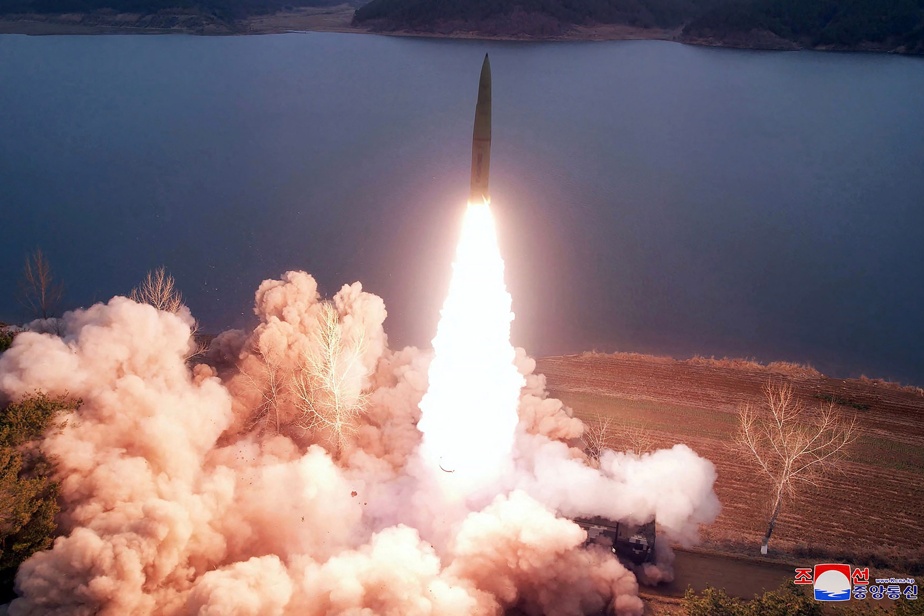(SEOUL) North Korea fired at least one intercontinental ballistic missile (ICBM) toward the Sea of Japan on Thursday, Seoul said, hours ahead of South Korean President Yoon Suk Yeol’s arrival in Tokyo.
“Our army detected a long-range ballistic missile fired from the Sunan area in Pyongyang,” the joint staff told AFP, telling AFP that it was an ICBM.
At a National Security Council meeting, Yoon called for stronger trilateral cooperation with Japan and the United States, adding that “North Korea will pay a fair price for these reckless provocations”, it said. his office in a statement.
Tokyo said the missile had reached a maximum altitude of more than 6,000 km.
Japanese Prime Minister Fumio Kishida announced to the press that he would meet the ministers of the National Security Council.
“Peace and stability in the region are very important issues for the countries concerned,” Kishida said.
Thursday’s launch came hours before the leaders of South Korea and Japan are due to meet in Tokyo, with Pyongyang’s nuclear and ballistic programs expected to be at the center of their discussions.
The summit is the first in 12 years between the two neighboring powers, which seek to mend ties long damaged by atrocities committed by Japan during its 35 years of colonial rule over Korea (1910-1945).
The two countries are currently increasing their defense spending and regularly hold joint military exercises, which Yoon said is essential for regional and global stability.
“South Korea and Japan increasingly need to cooperate in this time of ‘polycrisis’ where North Korea’s nuclear and missile threats are escalating,” South Korean President Yoon Suk Yeol said on Wednesday. in an interview with several media, including AFP.
It is Pyongyang’s third show of force since Sunday, when South Korea and the United States hold their biggest joint military drills in five years this week.
“Justify his hostile activities”
North Korea timed the launch on the day of the summit to achieve a “double effect”, namely a warning to its neighbors and a protest against the joint exercises between the United States and South Korea, according to experts.
In early March, leader Kim Jong-un ordered his army to intensify military maneuvers for “real war”.
“For a North Korea that is constantly looking for excuses to justify its hostile activities and weapons development, now is the perfect time for Kim to deploy its missiles,” said Soo Kim, a former CIA analyst in Korea. who now works for the management consulting firm LMI.
Leif Easley, professor at Ewha University in Seoul, felt that with this essay, Kim Jong-un wanted on the one hand “to threaten Tokyo”, which wishes “to deepen trilateral cooperation with Washington and Seoul”, and to on the other hand “dissuade South Korea from conducting further defense exercises with the United States”.
Washington and Seoul have strengthened their defense cooperation in the face of growing military and nuclear threats from Pyongyang, which has increased weapons tests in recent months.
North Korea fired two short-range ballistic missiles on Tuesday and two strategic cruise missiles from a submarine on Sunday, hours before the start of US-South Korea drills.
Called “Freedom Shield”, these exercises began on Monday and are to last 10 days. They focus on “the changing security environment” due to the redoubled aggressiveness of North Korea, the allies said.
North Korea views these drills as rehearsals for an invasion and regularly promises “crushing” action in response.
Thursday’s test “may be a normal-angle ICBM launch rehearsal or a verification of the North’s preparations for the launch of a reconnaissance satellite,” Yang Moo-jin, a professor at the University, told AFP. Seoul University of North Korean Studies.
North Korea has never fired its most powerful missiles on a normal trajectory, and experts doubt they have the technology to survive re-entry.
Pyongyang, which last year declared itself an “irreversible” nuclear power, has earlier announced that launching a military reconnaissance satellite was one of its priorities.
